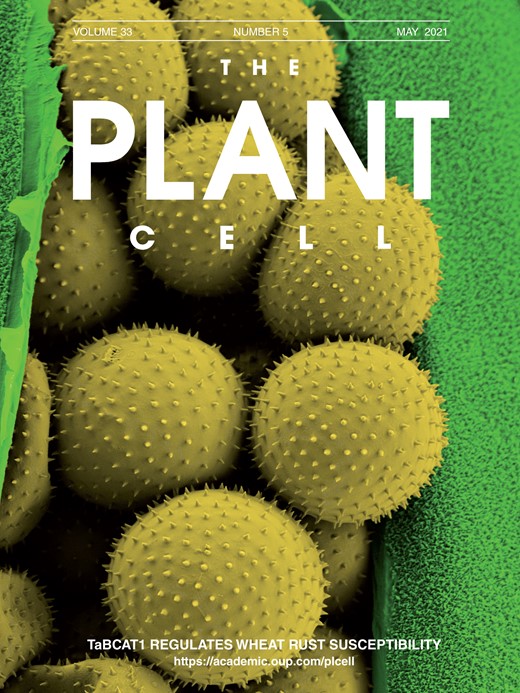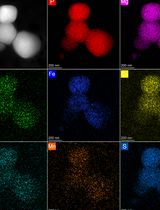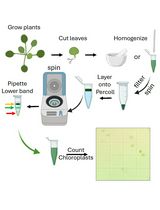- EN - English
- CN - 中文
Preparation and Transfection of Populus tomentosa Mesophyll Protoplasts
杨树中间叶原生质体的制备和转染
发布: 2021年11月20日第11卷第22期 DOI: 10.21769/BioProtoc.4220 浏览次数: 4011
评审: Wenrong HeYuan WangYe XuNicole Gibbs
Abstract
Mesophyll protoplasts freshly isolated from leaves are a useful research system in plants. However, cell walls in woody plants contain more pectin, making mesophyll protoplasts isolation difficult in Populus. This has limited their application in biochemical, molecular, cellular, genetic, genomic, transcriptomic, and proteomic assays. In this protocol, a simple and efficient method to prepare and transfect mesophyll protoplasts of Populus tomentosa is presented in detail. Leaves of P. tomentosa plants grown in tissue culture media were pre-treated in D-mannitol solution and then digested with an enzyme solution. After washing with W5 and MMg buffers, the protoplasts were incubated in PEG/Ca2+ solution with plasmid for transfection. The mesophyll protoplasts isolated were used to express the histone variant H2B fused with green fluorescent protein (GFP) for confocal microscopy imaging. This “P. tomentosa mesophyll protoplasts preparation and transfection” system provides a useful tool for studying woody plants using a variety of applications, including gene expression, subcellular localization, protein-protein interaction, chromatin immunoprecipitation, western blot, single-cell sequencing, and genome editing.
Keywords: Populus (胡杨)Background
As perennials species, Populus is an ideal model system to explore scientific questions that can not be easily addressed in annual plants such as Arabidopsis and rice (Jansson and Douglas, 2007). For instance, autumn leaf senescence (Wang et al., 2021), sex determination (Muller et al., 2020; Xue et al., 2020), wood formation (Chen et al., 2019), and seasonal dormancy (Tylewicz et al., 2018), can be more easily studied in Populus than in annual plants. As the lifespan of Populus plants usually spans decades, centuries, or even millennia (Munné-Bosch, 2008), it is necessary to establish a simple and rapid system to study gene function and signal transduction in woody plants. Mesophyll protoplasts are a powerful and versatile tool for conducting cell-based experiments to study gene function and signaling pathways (Yoo et al., 2007). They provide a good way to study important scientific questions at biochemical, molecular, cellular, genetic, genomic, transcriptomic, proteomic, and single-cell levels. Previously reported protocols for preparation and transfection of mesophyll protoplasts mainly focused on the model plant Arabidopsis (Yoo et al., 2007). However, the protocol for isolating Arabidopsis mesophyll protoplasts is not suitable for Populus protoplast preparation because of the different cell wall components (Lin et al., 2014). The protocol summarized here is a simple (fewer reagents, only four reagents are required) and efficient (less time, isolation and transfection takes approximately 7 h) procedure (Figure 1) compared with previously reported Populus protoplast preparation (Guo et al., 2012; Tan et al., 2013). A histone variant HTB9 fused with GFP is transiently expressed in P. tomentosa mesophyll protoplasts (Figure 2). This cellular system provides a helpful tool for studying gene expression in woody plants. Moreover, this protocol can also be applied for other Populus species leaves such as Populus alba, Populus trichocarpa, Populus alba × P. tremula var. glandulosa (84K), and Populus davidiana × P. bolleana, or leaves of other woody species such as Eucalyptus urophylla × E. grandis or Eucalyptus grandis × E. urophylla grown in tissue culture media.
Materials and Reagents
10 ml centrifugal tubes (HOUDIOR)
1.5 ml microfuge tubes (Axygen)
Blades (Gillette blue, Super Gillette Blue Blades, 4.3 cm × 2.2 cm)
Culture dish (90 mm diameter)
Glass-bottom dish (In Vitro Scientific, catalog number: D35-10-1.5-N)
Strainers, 400 mesh (BIODEE, catalog number: DE2009)
Cellulase “ONOZUKA” R-10 (Yakult, catalog number: L0012-10g)
Macerozyme R-10 (Yakult, catalog number: L0021-5g)
Pectolase Y-23 (Yakult, product agent (BIODEE) catalog number: AOV0094-1g)
MES (Sigma-Aldrich, catalog number: M3671-50G)
PEG4000 (Sigma-Aldrich, catalog number: 81240-1KG)
D-glucose (Sigma-Aldrich, catalog number: G7021-100G)
β-thioglycol (Amresco, catalog number: 0482-100 ml)
BSA (Amresco, catalog number: 0332-100g)
D-Mannitol (BIODEE, catalog number: BN20023-250g)
KCl (BIODEE, catalog number: DE-0395A-250g)
NaCl (BIODEE, catalog number: DE0008-500g)
MgCl2·6H2O (BIODEE, catalog number: DE-0288A-500g)
CaCl2 (BIODEE, catalog number: DE-0556A-500g)
Plasmid (dissolve in double distilled water, 2 µg/µl)
Enzymatic solution (see Recipes) (Table 1)
W5 solution (see Recipes) (Table 2)
MMg solution (see Recipes) (Table 3)
PEG/Ca2+ solution (see Recipes) (Table 4)
D-mannitol solution (see Recipes)
Equipment
1,000 µl micropipette (Eppendorf)
200 µl micropipette (Eppendorf)
10 ul micropipette (Eppendorf)
Cell counting plate (MARIENFELD, model: MARIENFELD-0650030)
Erlenmeyer flasks (Bomex, 50 ml, 500 ml)
Plant incubator (Percival, model: AR-36L3)
Bacterial shaker incubator (Crystal Technology & Industries, model: IS-AX-190L)
Centrifuge (Eppendorf, model: 5804 R)
Confocal microscope (Carl Zeiss, model: Zeiss LSM780)
Procedure
文章信息
版权信息
© 2021 The Authors; exclusive licensee Bio-protocol LLC.
如何引用
Wang, H. L., Wang, T., Yang, Q., Yin, W., Xia, X., Guo, H. and Li, Z. (2021). Preparation and Transfection of Populus tomentosa Mesophyll Protoplasts. Bio-protocol 11(22): e4220. DOI: 10.21769/BioProtoc.4220.
分类
植物科学 > 植物细胞生物学 > 细胞器分离
生物科学 > 生物技术
您对这篇实验方法有问题吗?
在此处发布您的问题,我们将邀请本文作者来回答。同时,我们会将您的问题发布到Bio-protocol Exchange,以便寻求社区成员的帮助。
提问指南
+ 问题描述
写下详细的问题描述,包括所有有助于他人回答您问题的信息(例如实验过程、条件和相关图像等)。
Share
Bluesky
X
Copy link












